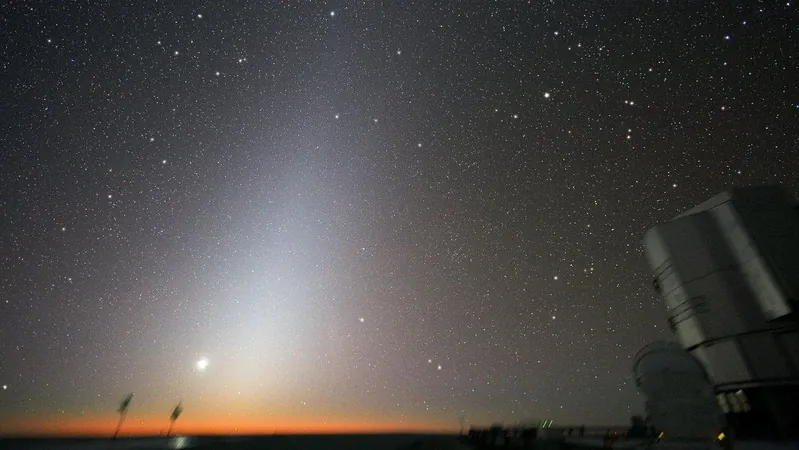
Discover the Magical ‘False Dawn’ This Weekend!
2025-09-20
Author: Sophie
Embrace the Enchantment of the Night Sky
Picture this: You're in a Dark Sky Park, gazing toward the east on a clear September night, and suddenly, you notice a mysterious triangular glow just before dawn. Is it an early sunrise, city lights, or perhaps even a planet's glow? Prepare to be captivated by the spectacular phenomenon known as the 'false dawn'!
What Exactly is 'False Dawn'?
This beautiful display—also referred to as zodiacal light—is not an early morning sunbeam but a soft illumination resulting from dust particles orbiting the sun. This ethereal glow will grace the eastern sky for the next two weeks, particularly shining brightest in the mornings following the new moon on September 20.
The Best Viewing Conditions
The 'false dawn' can only be spotted from locations with minimal light pollution, making it a truly memorable sight. Envision a gentle pyramid of light stretching across the horizon, perfect for night photography enthusiasts! Keep an eye out for this same phenomenon appearing in March, dubbed 'false dusk'.
Understanding Zodiacal Light
The glow you see is sunlight reflecting off tiny particles of interplanetary dust, remnants from comets and asteroids. Recent theories even suggest that some fragments might originate from Mars itself, adding a delicious twist to this cosmic spectacle.
When and Where to Spot It
If you want to catch a glimpse of this captivating light, look eastward around 90 minutes prior to sunrise between September 20 and early October. Make sure you're at a low horizon point free from urban light distractions!
Tips for an Unforgettable Experience
With the new moon making conditions favorable, here’s how to maximize your viewing experience: - Use a stargazing app in AR mode to locate the ecliptic or simply find true east using your phone compass. - Arrive early and spend about 20-30 minutes allowing your eyes to adjust to the darkness. - Try averted vision; by glancing slightly away from the glow, you might enhance its brightness. - Capture the magic with a night mode on your smartphone; aim for 10-second exposures with a steady tripod!
What Lies Ahead in the Night Sky?
Mark your calendars for September 22 when the autumnal equinox occurs! This date might bring a stunning surge of Northern Lights, thanks to Earth's magnetic alignment with solar winds. Plus, catch a partial solar eclipse visible from parts of New Zealand and the South Pacific—the perfect cosmic treat!
Prepare for an Adventure Under the Stars!
Make sure to use a sunrise/sunset calculator to find the exact timings in your area, and utilize resources like Stellarium Web for sky charts and the Night Sky Tonight app for planet positions. Wishing you clear skies and wide-eyed wonderment as you embark on this astronomical journey!









 Brasil (PT)
Brasil (PT)
 Canada (EN)
Canada (EN)
 Chile (ES)
Chile (ES)
 Česko (CS)
Česko (CS)
 대한민국 (KO)
대한민국 (KO)
 España (ES)
España (ES)
 France (FR)
France (FR)
 Hong Kong (EN)
Hong Kong (EN)
 Italia (IT)
Italia (IT)
 日本 (JA)
日本 (JA)
 Magyarország (HU)
Magyarország (HU)
 Norge (NO)
Norge (NO)
 Polska (PL)
Polska (PL)
 Schweiz (DE)
Schweiz (DE)
 Singapore (EN)
Singapore (EN)
 Sverige (SV)
Sverige (SV)
 Suomi (FI)
Suomi (FI)
 Türkiye (TR)
Türkiye (TR)
 الإمارات العربية المتحدة (AR)
الإمارات العربية المتحدة (AR)